
e-Way Bill - Explained
During my small span of consulting, I came across multiple occasions wherein there are misconceptions about e-Way billing provisions under GST. The E-way bill is an electronic bill generated through the GST portal. This document is required for the movement of goods. Any supplier/agent is transporting goods where the value of the consignment is greater than Rs. 50,000 is required to generate and produce this e-way bill. Please note that there is no specification of any distance mentioned. It comprises of two parts and they are: 1. Part A request for the details such as recipient GSTIN, place of delivery, invoice or challan number and date, HSN code, goods value, transport document number (Goods Receipt Number in the case of road transport) and reasons for transportation. 2. Part B comprises of transporter details (Vehicle number and transporter ID). The part B containing transport detail is used to generate the e-way bill. Following are some of the important points to be noted for goods transported through road: 1. Vehicle number should be provided along with the transporter ID in part B. This is mainly provided by the GTA’s (Goods Transport Agency) 2. Where the goods are transported by a supplier, then the supplier must provide details in Part-A required for the generation of the e-way bill to the transporter. 3. Based on the information provided by the supplier, the transporter then generates the e-way bill by completing Part-B. 4. If goods are transported in an own vehicle or a hired vehicle by a supplier then the supplier can himself fill in the Part-B information. 5. EBN or unique e-way bill number is generated once the transporter provides the information about the transport or vehicle number etc. 6. If during the transit, if the vehicle is changed then transporter will have to update details of conveyance in the e-way bill on the GST portal. 7. Goods can be transported with just Part-A details only: a) If goods are transported for a distance of less than 50 km within the State from suppliers place to a transporter for delivery b) If goods are transported for a distance of less than 50 km from a supplier to a recipient 8. E-way bill generated on the GST portal is valid across all States and Union Territories. 9. For a distance up to 100 km, the E-way bill generated is valid for one day. For every 100 additional km, the e-way bill will be valid for an additional day. 10. If due to some unforeseen situations, the transport cannot be completed within the validity period then the transporter can generate a new e-way bill by updating transport details. The reason for transportation can be any like supply, sales return, own use, job work, etc. 11. If there are multiple vehicles involved in the goods transport, and then the supplier should issue the invoice before the completion of the first consignment and for each subsequent consignment, there should be copies of corresponding delivery challans and an invoice copy. However, the original invoice will be sent with the last consignment.



